Jargon
S.B. System
Simultaneous(ly) Broadcast System - The linking of two or more transmitters by telephone lines for the purpose of broadcasting the same programme. Initially, the eight BBC stations provided all their own programmes but from August 1923 news bulletins from London were "SB to all stations". Soon this and similar phrases such as "SB from Belfast" appeared under programme billings in Radio Times. By the 1930s it had become very much an internal BBC abreviation.
E.i.C.
Engineer in Charge.
P.B.X.
Private Branch Exchange.
The Post Office
The General Post Office was responsible for telecommunications systems at this time. British Telecom was created in 1980, still as part of the PO. The following year an act of Parliament transfered telecom responsibility away from the PO and created two separate corporations.
Simultaneous(ly) Broadcast System - The linking of two or more transmitters by telephone lines for the purpose of broadcasting the same programme. Initially, the eight BBC stations provided all their own programmes but from August 1923 news bulletins from London were "SB to all stations". Soon this and similar phrases such as "SB from Belfast" appeared under programme billings in Radio Times. By the 1930s it had become very much an internal BBC abreviation.
E.i.C.
Engineer in Charge.
P.B.X.
Private Branch Exchange.
The Post Office
The General Post Office was responsible for telecommunications systems at this time. British Telecom was created in 1980, still as part of the PO. The following year an act of Parliament transfered telecom responsibility away from the PO and created two separate corporations.
The staff came from England, Scotland, Ireland and Wales and, under the E.i.C., Mr. J. B. Basébé, were a most friendly crowd often coming in to the Control Room when off duty for a cup of tea, joined by the two Irish sisters who operated the P.B.X.
The S.B. line feed to Belfast was from Glasgow via a Post Office submarine cable and the feed was frequently lost. To cover this, the Belfast staff used a frame aerial on a vertical shaft outside the window of the Control Room. This raised the aerial above the roof of the building and a car steering wheel on the bottom of the shaft provided a pick up of programme from either the Scottish or the North of England Regional Transmitter. In this connection, Mr. Basébé would sometimes come into the Control Room and with his hand on a connection block on the distribution frame, arrange for the ring on his finger to "short out" the Control Room loudspeaker. This was his way of checking how efficient the staff were, who assumed the line from Glasgow had "gone down". They restored programme by switching to the radio feed from the appropriate Regional Transmitter.
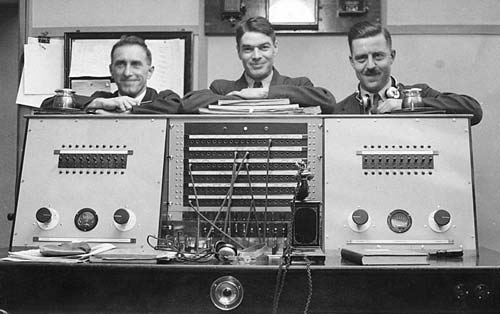
The main desk in 1936. left to right: Reg Bullen, 'LG'
Smith and unknown.
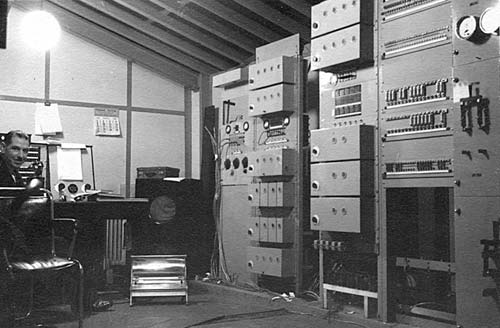
photographed on the 8th March, 1936
Tired of waiting for new equipment after all the other regions had got new control rooms, this desk was constructed by control room staff under the E.i.C. Mr Basébé. Built on an office table and using components removed from an O.B. four channel fade unit, the whole desk was finished in warship grey by courtesy of Harland and Woolf.
The Control Room was equipped with two rows of bays, one on the left of the main desk with line termination and test equipment and the other row (right) to the right of the desk. This was made up of about eight bays, some "standard" bays, some made of angle iron. The fuse bay consisted of a sheet of metal fixed between two other bays and containing fuses for all the Control Room equipment. Much of the wiring was taken direct to the jackfields, etc, without going via mounted terminal blocks. During the summer of 1936 this row of bays was replaced by standard equipment occupying the same position.
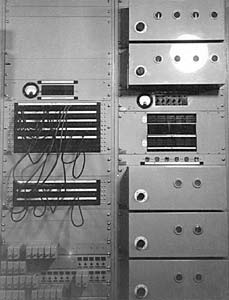
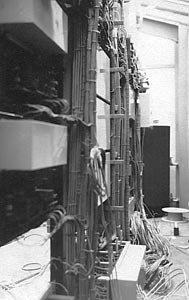
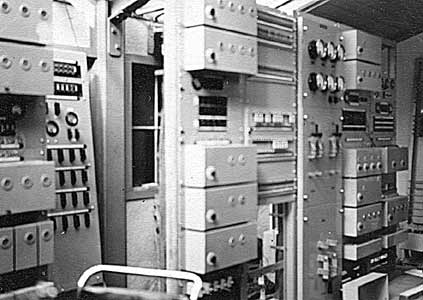
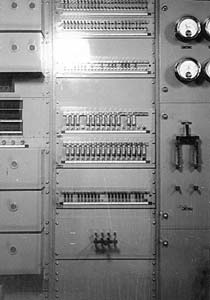
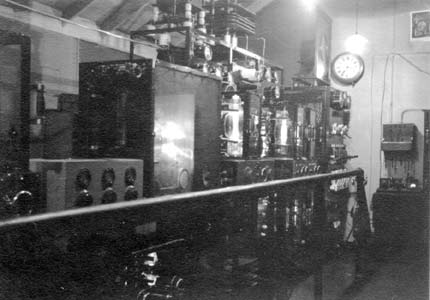
Right: A view of the Belfast transmitter. This was in the East Bridge Power Station with the chimney used to support the aerial.

